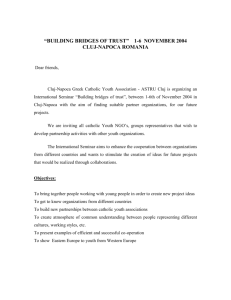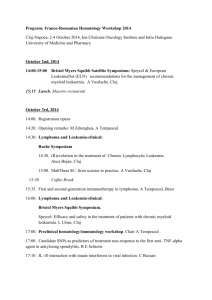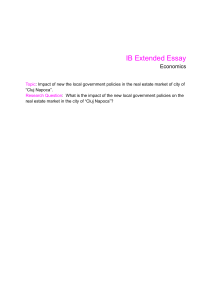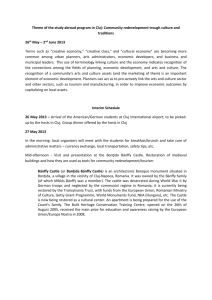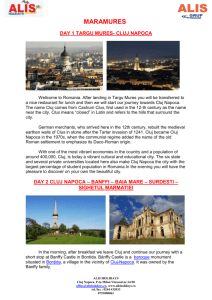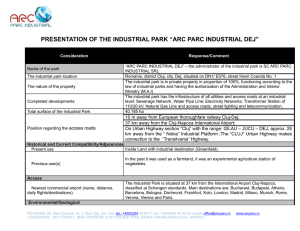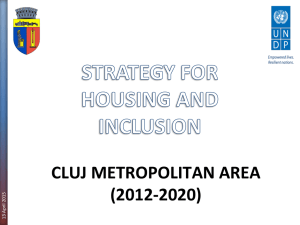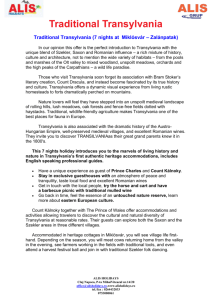Strategic Planning for Cluj-Napoca (2013-2020
advertisement
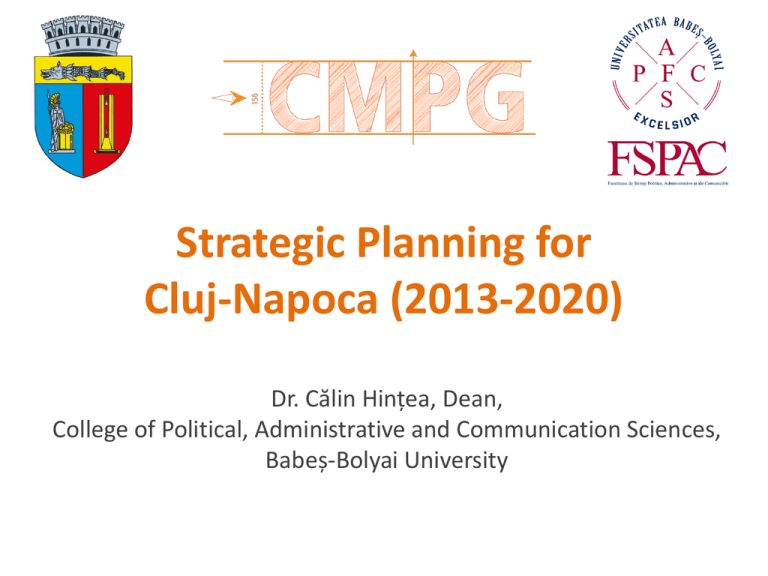
Strategic Planning for Cluj-Napoca (2013-2020) Dr. Călin Hințea, Dean, College of Political, Administrative and Communication Sciences, Babeș-Bolyai University National Context • Lack of strategic planning capabilities at the level of central government; • Lack of substance with regard the process of strategic planning at the local level (the only motivation being to gain access to European funds); • Poor understanding by the local decision-makers of the advantages of strategic planning; • Planning seen as an activity confined to the level of the top elected local official (the mayor) and a small group providing technical assistance (civil servants and/or consultants); • Simplistic approach: traditional solutions limited to infrastructure, specific projects, obtaining transfers from the central budget, local revenue spending (i.e. culture as a field which generates resources at the local level); • Incapacity to identify and direct efforts toward a set of strategic fields capable of generating a competitive advantage at the local level. Key concepts 1. Quality of Life The aim is to create a sophisticated community/city, with: (1) an economy and services based on smart solutions for growth, entrepreneurship and creativity; (2) a high level of prosperity; (3) a dynamic academic community and (4) multiple choices in terms of quality of life. In summary, we envision a community that attracts (and maintains) a sophisticated and entrepreneurial human resource due to its high quality of life. Quality of life Quality of life Quality of life Key concepts 2. Involvement of the expert groups within the community • Cluj-Napoca is not the type of community in which administrative management identifies the strategic development objectives in an isolated manner and then “guides” people in the right direction. • The city needs strategic assets such as the creativity and the energy coming from the community, while the local government has the role of facilitating and integrating the strategic perspectives already present in the community. • A possible source capable of generating a competitive advantage: various capabilities and expertise placed at different level within the local community: universities, NGOs, local businesses, international businesses, cultural players, etc. Methodology 1. Preliminary Structural Analysis (PSA): a. Quantitative research on quality of life perception in Cluj Napoca 10-17 January 2013; 912 respondents; 196 indicators; 18 areas, 7 chapters. Indicators -Quality of life. A model for Cluj Napoca Self-evaluation of the quality of life Lifestyle I. Self-evaluation of the quality of life Family Positioning Quality of life at the community level Safety II. Safety Liberty Gender equality Quality of the healthcare system III. Health Emotional health IV. Education Education V. Environment Quality of the environment VI. Quality of governance Quality of governance Physical health Economic prosperity VII. Economic prosperity Access to housing Workplace Access to basic services Methodology 1. Preliminary Structural Analysis (PSA): b. An analysis of the strategic framework: European, National, Regional, County level. c. Analysis of previous strategic planning processes/plans for Cluj-Napoca (2006-2012) d. Analysis of statistical data (demography, social issues, economy, environment, civil society) e. Local economic development analysis (growing, transforming, and declining sectors, opportunities) f. The competitive advantage of the city-a preliminary analysis (growth pole based on the university sector: Debrecen, Szeged, Mannheim, Graz, Linz; growth pole based on healthcare: Debrecen, Szeged, Graz, Linz; movie industry as a trigger for growth: Karlovy Vary, Sofia, Berlin) Methodology 1. Developing the vision for the community (2013-20…..): Cluj defines its development in terms of quality of life of its inhabitants. It is a space for personal and collective accomplishments, with active citizens, a creative, complex, dynamic and competitive economic environment, capable of utilizing the resources in an integrated fashion and of offering a sustainable development path for the community. Cluj is a model city in terms of good governance, having a transparent, progressive, and highly performing public administration, for which citizens are partners. Cluj is a pole for academic excellency, where the academic community is engaged in the community's life, representing a source for creativity, innovation, and research. Cluj is a European cultural landmark, where culture represents a transversal factor in the organizing of the community; the city has a vibrant and dynamic cultural life, which facilitate and encourages experimenting and initiative. Cluj defines itself as a European city, the historic core of Transylvania, a community with a unique character built on multiculturalism. Cluj is a network of interconnected communities, a laboratory for social creativity, a youthful city, equally friendly and responsible. Viziune Strategic dimensions Peoples and community Innovative, creative, competitive City Safe City Healthy City Cluj-Napoca (quality of life) Culture and local identity Urban Development and spatial planning Green City Good governance Cluj-Napoca People and community Innovative, creative, and competitive city WG Associativity and philanthropy WG Local economic development WG Multiculturalism Urban development and spatial planning WG urban development/spatial planning Green city Good governance Culture and local identity WG E-government WG European dimension of Cluj WG Tourism WG Quality of public services WG Regional leadership WG Higher education WG IT WG Participation WG Movie industry WG Secondary education WG Placemaking/territorial marketing WGSocial inclusion WG Entrepreneurship and innovation in community WG Environmrent Healthy city WG Public health Safe city WG Safe City WG Historical identity of the city WG Culture and creative industries WG Demography and human resources WG Community mediation WG Youth WG Ethics in the public arena Working groups Methodology 3. Sectorial public policy analysis at community level (working groups -WG) • 26 WG • Each WH has between 1-3 coordinators • Selection of the coordinators based on: a) expertise in the field of the WG b) capacity to identify and gather important stake-holders in that field • Autonomy of the WG; balanced through the use of a common methodological framework • Final WG reports due in December Methodology 3. Sectorial public policy analysis at community level (WG). Common WG methodology The general methodology will include at least the following elements: (a) a preliminary analysis of the field/domain/sector, (b) a PEST analysis/SWOT analysis, (c) the identification of key strategic issues (max. 5), (d) drafting of sectorial strategies and (e) proposals for operational programs (max 15/prioritized)- a base for multiannual budgeting and future projects Methodology 4. Identifying key strategic factors (KSF) at community level (strategic profile of the city, competitive advantage) 5. The action plan for developing strategic objectives at community level (operational plans included). Future projects for funding. 6. Establishing monitoring and evaluation systems (local administration and community) 7. Voting by the Local Council. The planning process can be observed in real time on www.cmpg.ro Partners • International cooperation: Dutch initiative, Michigan State University, etc. • Programs developed/facilitated in this context; Cluj Innovation City, Participatory Budgeting Advantages • A possible pilot program offering best practices to be used in other communities as well. • Understanding of the importance and of the advantages generated by strategic planning at the local level (later on possibly at the central level as well). • Moving away from the mere drafting of strategic documents towards developing creative thinking and strategic initiative. • Importance of the community’s engagement in the strategic planning processes: managerial quality and participation. • Development of a multiannual budgetary planning and execution and use of limited resources for a limited number of pre-defined strategic objectives. Thank you hintea@fspac.ro
